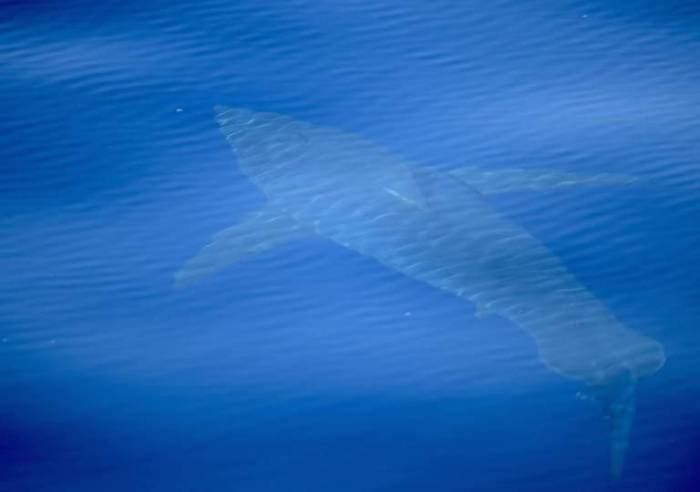Researchers who caught sight of the 16ft shark near the Balearic Islands yesterday say it is the first time in more than 30 years a great white has been seen in the area.
Numbers of great whites – featured in the film Jaws and widely feared because they can attack swimmers and surfers – have dropped sharply in recent decades because of overfishing, accidental catches in nets and discarded fishing gear. They are also caught for shark-fin soup, considered a delicacy in China and Hong Kong.
The expedition team from the Spanish Alnitak marine research centre said they photographed the shark eight miles off the coast of the island of Cabrera, south of Majorca, and observed it for more than an hour.
The centre said in a post on Facebook: “In recent years there were possible unconfirmed sightings and various rumours, but this is the first scientific observation of the presence of Carcharodon (shark) in Spanish waters for at least 30 years.
“On this occasion, this historic sighting has been photographed, filmed and contemplated by a crew of 10 people from five countries.”
Great whites are normally associated with South Africa and Australia – but are native to the Mediterranean, where they can live up to the age of 70, according to the Shark Trust in the UK.
Despite their reputation for attacking humans, a relatively low number of attacks have proved fatal, and marine biologists believe the creatures “test-bite” to explore things that enter their territory. Listed as a critically endangered species, they should not be hunted.
But in 2016, there was uproar after a picture of divers posing with a dead great white shark they caught in the Mediterranean appeared online.
Alnitak said for at least 30 years no evidence like that taken from their ship had been seen.
The expedition on board the Toftevaag, whose crew includes Briton Georgina Stevens, was exploring the coast of Majorca to gather data on sea turtles, sperm whales, dolphins, red tuna and the effects of microplastics pollution.
A spokeswoman for the Shark Trust told that great whites were critically endangered and were few and far between. Experts worldwide were now trying to confirm whether the sighting really was a great white because there can be confusion, she said.
John Richardson, conservation officer at the trust, said: “This is a spectacular photo of a very impressive shark.
“Based on the one photo we’ve seen, the shark in question could be either a great white shark (Carcharodon carcharias) or a shortfin mako (Isurus oxyrinchus). Given the rarity of white sharks and shortfin mako in Mediterranean waters, the Shark Trust would be delighted with confirmation of either.”
Some Facebook followers of Alnitak also doubted the identification. Klaus Busse wrote: “It does not look like a white shark to me ... the pectoral fins look very pointed, and the dorsal fin looks pretty small for a white shark.”
But Opositor Palma wrote: “No doubt it's a white shark, it's unmistakable.”
Mr Richardson said that following centuries of intensive fishing, both great whites and shortfin makos were listed as critically endangered in Mediterranean waters – a category for species that face an extremely high risk of extinction in the wild.
“At least 53 per cent of sharks, rays and chimaeras native to the Mediterranean Sea are at risk of extinction and require urgent action to conserve their populations and habitats,” he added.
The Toftevaag crew, led by marine biologist Ricardo Sagarminaga also included two 16-year-old students, Miguel Felix Arboledas and Nahim Lasgaa Capo, from Majorca, who won a scholarship by writing a rap song about plastic pollution in the oceans.
The Independent
More about: shark
















































